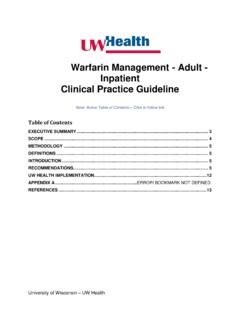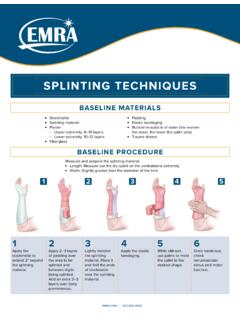Transcription of Triage and the “ABCD” Concept
1 Triage and the ABCD Concept ETAT Module 1 Adapted from Emergency Triage Assessment and Treatment (ETAT): Manual for Participants, World Health Organization, 2005 Learning Objectives Understand the importance of continually assessing the medical needs of all children from arrival at the healthcare facility until discharge Recognize emergency (ABCD) and priority signs Assign children Triage categories, based on emergency and priority signs Identify the appropriate immediate response for children in each Triage category Target Audience All centre staff who have contact with patients Assessment and immediate response to emergency and priority patients will vary depending on whether or not you are a healthcare provider overview What is Triage ? Performing a rapid assessment The ETAT tool Emergency signs Priority signs Triage : what and why What: Sorting patients into priority groups according to their needs and the resources available Why: Identify and treat seriously ill children as soon as possible to prevent deterioration in their conditions Triage process When: as soon as the child arrives at the healthcare facility and periodically throughout the visit Where: at various locations, depending on the facility (outpatient queue, waiting room, designated Triage area) Who: all clinical staff How: rapid assessment performed within 15-20 seconds, without using equipment or taking vital signs How to perform a rapid assessment Look and listen What is the overall appearance of the child?
2 Is he playful and interactive? Is she quiet or poorly responsive? For children who are ill appearing, systematically look for the presence of emergency and priority signs ETAT: Emergency Triage Assessment Treatment Tool Reliably sorts children into the following treatment categories: immediate emergency treatment (E) rapid assessment and treatment (P) with non-urgent conditions (N) Adapted from ETAT manual for participants, Chart 2 page 67 3 TPR T: tiny baby, temperature, trauma P: pallor, poisoning, pain R: respiratory distress, restless, referral MOB M: malnutrition O: oedema B: burn Airway Breathing (severe) Circulation Coma Convulsion Dehydration (severe) Emergency Signs Priority Signs Emergency signs Airway Breathing Circulation Coma Convulsion Dehydration (severe) Airway Is the airway obstructed? Signs of airway obstruction Complete obstruction: no air movement Partial airway obstruction: noisy breathing during inspiration Case # 1 You are at the registration desk.
3 You notice a child with a small toy in her mouth. Suddenly, she begins to choke. What should you do? She is in severe distress and choking but she is not making any sound. What is her Triage category? What should you do next? Emergency Call the Triage nurse. Breathing (1) What is the child s color? Pink Pale Grey Blue Is the child breathing? Does the chest wall move with inspiration and expiration? Breathing (2) Is there increased work of breathing? Can the child nurse or talk? Is there severe indrawing of the chest? What is the rate and pattern of breathing? Too fast Too slow Agonal breathing: irregular, slow Abnormal patterns Deep, slow (as with acidosis) Irregular (as with brain abnormalities) Increased Work of Breathing Anxious Nasal flaring Indrawing of chest Between the ribs Below the breast bone PALS: Rapid Cardiopulmonary Assessment, American Heart Association 2001 Case # 2 A caretaker calls you to the waiting room because she is concerned about the child sitting next to her.
4 The infant is pale and appears anxious and uncomfortable. Is this baby sick or well? He is sick. What should you do next? Assess airway and breathing. There is no noisy breathing. The respiratory rate is rapid and there is marked indrawing of the chest. Describe his respiratory status. The airway is patent. He has increased work of breathing. What is his Triage status? What should you do? Emergency (respiratory distress) Call for help. Circulation If the child s hands are warm, circulation is OK. For children with cold hands, assess the capillary refill Prolonged Capillary Refill Press an area on the patient s extremity with your finger until it is pale. Color should return to the skin within 3 seconds after you remove your finger. PALS: Rapid Cardiopulmonary Assessment, American Heart Association 2001 Coma (mental status) A (alert) V (responds to voice): lethargic P (responds to pain): coma U (unresponsive): coma Coma (mental status) A V P (responds to pain): coma U (unresponsive): coma Case # 3 A mother comes to the registration desk with her infant wrapped in a blanket.
5 What should you do in order to assess the baby? Ask the mother to unwrap the baby. She is limp and unresponsive. What is her Triage category? What should you do? Emergency (U = coma) Call for help. Convulsions Sudden loss of consciousness Uncontrolled jerking of arms and/or legs Twitching of face and/or eyes ,accessed 2/9/08 Dehydration (with severe diarrhea) Lethargy Sunken eyes Skin pinch goes back very slowly (longer than 2 seconds) Accessed through Google images, 2/9/08 Case # 4 As you walk through the waiting room, you notice a lethargic small child lying in his mother s lap. His eyes are sunken. His mother says that he has had diarrhea for 3 days. What is his Triage category? Emergency (Severe dehydration) Call for help. Triage process to identify emergency signs Triage steps Response Assess Airway Positive: Stop. Call for help Negative: assess Breathing Assess Breathing Positive: Stop.
6 Call for help Negative: assess Circulation Assess Circulation (coma, convulsions) Positive: Stop. Call for help Negative: assess Dehydration Assess Dehydration Positive: Stop. Call for help Negative: assess Priority signs Adapted from ETAT manual for participants, page 8 Assess Airway Positive Negative Stop. Call for help Assess Breathing Positive Negative Stop. Call for help Assess Circulation, Coma, and Convulsion Positive Negative Assess Dehydration (with diarrhea) Negative Positive Stop. Call for help Assess for Priority Signs Stop. Call for help If any sign is positive, call for help!! Adapted from ETAT manual for participants, Chart 2 page 67 Priority Signs 3 TPR T: tiny baby, temperature, trauma P: pallor, poisoning, pain R: respiratory distress, restless, referral MOB M: malnutrition O: oedema B: burn Priority signs: 3 TPR T Tiny baby Temperature Trauma (or other surgical condition) P Pallor (severe) Poisoning Pain (severe) R Respiratory distress Restless, continuously irritable, or lethargic Referral (urgent) Tiny Baby: under two months of age More difficult to assess properly More likely to get serious infections More likely to deteriorate quickly Temperature Hot to touch: fever is a sign of infection Cold to touch.
7 May be a sign of poor circulation or serious infection Trauma (or other urgent surgical condition) Head injury fracture Acute abdomen Poisoning Ask caretaker if this is the reason for visit Child s condition can deteriorate rapidly Specific treatments may be required Pain Pain may be due to serious conditions (meningitis, acute abdomen, sickle cell painful crisis) Patient should receive treatment for pain relief Pallor Unusual paleness of skin Compare the child s palm to your palm Indication of anemia ETAT provider manual, page 7 Respiratory Distress Signs of respiratory distress that are not severe Rapid breathing Indrawing of chest Noisy breathing inspiratory: stridor (upper airway obstruction) expiratory: wheezing (lower airway obstruction) Restlessness Restlessness, continuous irritability, and/or lethargy may be due to serious conditions (meningitis, acute abdomen, sickle cell painful crisis) Referral (from another centre) Look carefully at patients who are referred from another centre.
8 The patient has already been evaluated by another healthcare provider who has determined that he is very sick. Use information from the referring centre and your assessment to determine if the child has an urgent condition. Priority signs: MOB Malnutrition (visible wasting) Oedema of both feet Burn (major) When management resources are limited Use guidelines from Integrated management of Childhood Illness (IMCI). IMCI chartbook uses the same assessment and classification principles as ETAT. management recommendations emphasize recognizing patients that should be stabilized and transferred. ABCD Severe disease OR Local bacterial infection Positive sign Not feeding well OR Convulsion OR Rapid breathing OR Severe chest indrawing OR Fever OR low temperature Poorly responsive Manage Keep patient warm (skin to skin) Give first dose of antibiotic Refer urgently to hospital Assessment and classification.
9 IMCI under 2 months Danger signs Any positive sign OR Chest indrawing OR Stridor in a calm child OR Severe pneumonia OR Very severe disease Manage Keep patient warm (skin to skin) Give first dose of antibiotic Refer urgently to hospital IMCI Danger signs for >2 months-5 years Any general danger sign OR Stiff neck Very severe febrile disease Manage Keep patient warm (skin to skin) In areas endemic for malaria, give first dose of quinine for severe malaria Give first dose of antibiotic Treat to prevent low blood sugar Give one dose of paracetamol for high fever (> ) Refer urgently to hospital IMCI: Temperature >2 months-5 years Visible wasting OR edema of both feet Severe malnutrition Manage Keep patient warm (skin to skin) Treat to prevent low blood sugar Refer urgently to hospital IMCI: Malnutrition for >2 months-5years Severe palmar pallor Severe anemia Manage Refer urgently to hospital IMCI: Severe anemia >2 months-5 years 3 TPR T: tiny baby, temperature, trauma P: pallor, poisoning, pain R: respiratory distress, restless, referral MOB M: malnutrition O: oedema B: burn Airway Breathing (severe) Circulation Coma Convulsion Dehydration (severe) Emergency Signs Priority Signs Summary ETAT categories: Emergency Rapid assessment performed within 15-20 seconds Identify emergency signs (ABCCCD) Call for help Initiate appropriate emergency treatment Adapted from ETAT manual for participants, Chart 2 page 67 ETAT categories: Priority No emergency signs Identify priority signs (3 TPR-MOB) Child needs prompt, but not emergency assessment and treatment Notify Triage nurse who will complete Triage evaluation Move to front of queue ETAT categories.
10 Non-urgent No emergency signs No priority signs Child may be seen in queue






